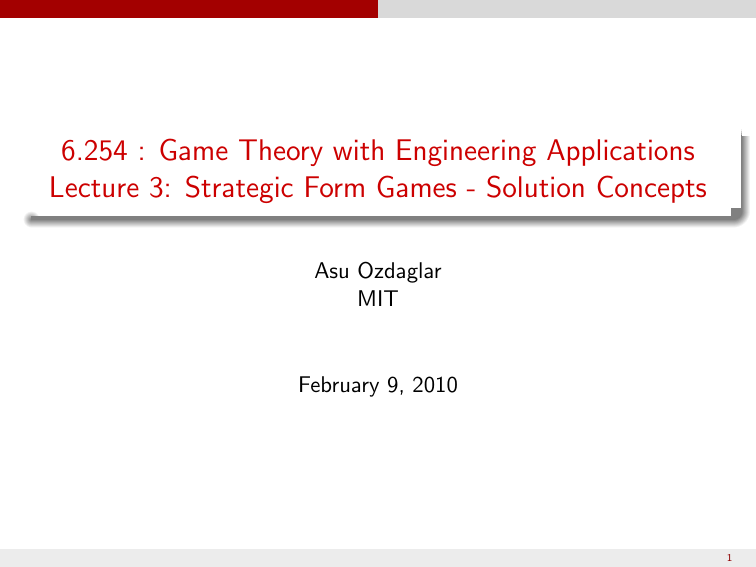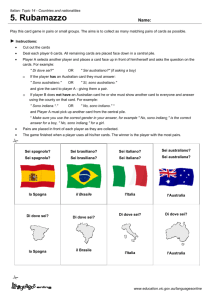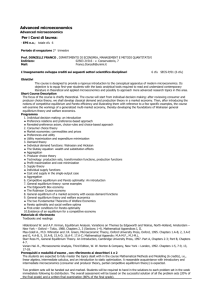Document 13383694
advertisement

6.254 : Game Theory with Engineering Applications
Lecture 3: Strategic Form Games - Solution Concepts
Asu Ozdaglar
MIT
February 9, 2010
1
Game Theory: Lecture 3
Introduction
Outline
Review
Examples of Pure Strategy Nash Equilibria
Mixed Strategies and Mixed Strategy Nash Equilibria
Characterizing Mixed Strategy Nash Equilibria
Rationalizability
Reading:
Fudenberg and Tirole, Chapters 1 and 2.
2
Game Theory: Lecture 3
Nash Equilibrium
Pure Strategy Nash Equilibrium
Definition
(Nash equilibrium) A (pure strategy) Nash Equilibrium of a strategic
game �I , (Si )i ∈I , (ui )i ∈I � is a strategy profile s ∗ ∈ S such that for all
i∈I
∗
∗
ui (si∗ , s−
for all si ∈ Si .
i ) ≥ ui (si , s−i )
Why is this a “reasonable” notion?
No player can profitably deviate given the strategies of the other
players. Thus in Nash equilibrium, “best response correspondences
intersect”.
Put differently, the conjectures of the players are consistent: each
∗ , and each
player i chooses si∗ expecting all other players to choose s−
i
player’s conjecture is verified in a Nash equilibrium.
3
Game Theory: Lecture 3
Examples
Example: Second Price Auction
Second Price Auction (with Complete Information) The second price
auction game is specified as follows:
An object to be assigned to a player in {1, .., n }.
Each player has her own valuation of the object. Player i’s valuation
of the object is denoted vi . We further assume that v1 > v2 > ... > 0.
Note that for now, we assume that everybody knows all the valuations
v1 , . . . , vn , i.e., this is a complete information game. We will analyze
the incomplete information version of this game in later lectures.
The assignment process is described as follows:
The players simultaneously submit bids, b1 , .., bn .
The object is given to the player with the highest bid (or to a random
player among the ones bidding the highest value).
The winner pays the second highest bid.
The utility function for each of the players is as follows: the winner
receives her valuation of the object minus the price she pays, i.e.,
vi − bj ; everyone else receives 0.
4
Game Theory: Lecture 3
Examples
Second Price Auction (continued)
Proposition
In the second price auction, truthful bidding, i.e., bi = vi for all i, is a
Nash equilibrium.
Proof: We want to show that the strategy profile (b1 , .., bn ) = (v1 , .., vn )
is a Nash Equilibrium—a truthful equilibrium.
First note that if indeed everyone plays according to that strategy,
then player 1 receives the object and pays a price v2 .
This means that her payoff will be v1 − v2 > 0, and all other payoffs
will be 0. Now, player 1 has no incentive to deviate, since her utility
can only decrease.
Likewise, for all other players vi �= v1 , it is the case that in order for
vi to change her payoff from 0 she needs to bid more than v1 , in
which case her payoff will be vi − v1 < 0.
Thus no incentive to deviate from for any player.
5
Game Theory: Lecture 3
Examples
Second Price Auction (continued)
Are There Other Nash Equilibria? In fact, there are also unreasonable
Nash equilibria in second price auctions.
We show that the strategy (v1 , 0, 0, ..., 0) is also a Nash Equilibrium.
As before, player 1 will receive the object, and will have a payoff of
v1 − 0 = v1 . Using the same argument as before we conclude that
none of the players have an incentive to deviate, and the strategy is
thus a Nash Equilibrium.
It can be verified the strategy (v2 , v1 , 0, 0, ..., 0) is also a Nash
Equilibrium.
Why?
6
Game Theory: Lecture 3
Examples
Second Price Auction (continued)
Nevertheless, the truthful equilibrium, where , bi = vi , is the Weakly
Dominant Nash Equilibrium
In particular, truthful bidding, bi = vi , weakly dominates all other
strategies.
Consider the following picture proof where B ∗ represents the
maximum of all bids excluding player i’s bid, i.e.
B ∗ = max bj ,
j � =i
and
v∗
is player i’s valuation and the vertical axis is utility.
ui(bi)
v*
bi = v*
ui(bi)
B*
bi v*
bi < v*
ui(bi)
B*
v* b
i B*
bi > v*
7
Game Theory: Lecture 3
Examples
Second Price Auction (continued)
The first graph shows the payoff for bidding one’s valuation. In the
second graph, which represents the case when a player bids lower
than their valuation, notice that whenever bi ≤ B ∗ ≤ v ∗ , player i
receives utility 0 because she loses the auction to whoever bid B ∗ .
If she would have bid her valuation, she would have positive utility in
this region (as depicted in the first graph).
Similar analysis is made for the case when a player bids more than
their valuation.
An immediate implication of this analysis is that other equilibria
involve the play of weakly dominated strategies.
8
Game Theory: Lecture 3
Mixed Strategies
Nonexistence of Pure Strategy Nash Equilibria
Example: Matching Pennies.
Player 1 \ Player 2 heads
tails
heads
(−1, 1) (1, −1)
tails
(1, −1) (−1, 1)
No pure Nash equilibrium.
How would you play this game?
9
Game Theory: Lecture 3
Mixed Strategies
Nonexistence of Pure Strategy Nash Equilibria
Example: The Penalty Kick Game.
penalty taker \ goalie
left
right
left
(−1, 1) (1, −1)
right
(1, −1) (−1, 1)
No pure Nash equilibrium.
How would you play this game if you were the penalty taker?
Suppose you always show up left.
Would this be a “good strategy”?
Empirical and experimental evidence suggests that most penalty
takers “randomize”→mixed strategies.
10
Game Theory: Lecture 3
Mixed Strategy Equilibrium
Mixed Strategies
Let Σi denote the set of probability measures over the pure strategy
(action) set Si .
For example, if there are two actions, Si can be thought of simply as a
number between 0 and 1, designating the probability that the first
action will be played.
We use σi ∈ Σi to denote the mixed strategy of player i, and
σ ∈ Σ = ∏i ∈I Σi to denote a mixed strategy profile.
Note that this implicitly assumes that players randomize
independently.
We similarly define σ−i ∈ Σ−i = ∏j �=i Σj .
Following von Neumann-Morgenstern expected utility theory, we
extend the payoff functions ui from S to Σ by
ui ( σ ) =
�
S
ui ( s ) d σ ( s ) .
11
Game Theory: Lecture 3
Mixed Strategy Equilibrium
Mixed Strategy Nash Equilibrium
Definition (Mixed Nash Equilibrium)
A mixed strategy profile σ∗ is a (mixed strategy) Nash Equilibrium if for
each player i,
ui (σi∗ , σ∗−i ) ≥ ui (σi , σ∗−i )
for all σi ∈ Σi .
It is sufficient to check only pure strategy “deviations” when
determining whether a given profile is a (mixed) Nash equilibrium.
Proposition
A mixed strategy profile σ∗ is a (mixed strategy) Nash Equilibrium if and
only if for each player i,
ui (σi∗ , σ∗−i ) ≥ ui (si , σ∗−i )
for all si ∈ Si .
12
Game Theory: Lecture 3
Mixed Strategy Equilibrium
Mixed Strategy Nash Equilibria (continued)
We next present a useful result for characterizing mixed Nash
equilibrium.
Proposition
Let G = �I , (Si )i ∈I , (ui )i ∈I � be a finite strategic form game. Then,
σ∗ ∈ Σ is a Nash equilibrium if and only if for each player i ∈ I , every
pure strategy in the support of σi∗ is a best response to σ∗−i .
Proof idea: If a mixed strategy profile is putting positive probability on a
strategy that is not a best response, then shifting that probability to other
strategies would improve expected utility.
13
Game Theory: Lecture 3
Mixed Strategy Equilibrium
Mixed Strategy Nash Equilibria (continued)
It follows that every action in the support of any player’s equilibrium
mixed strategy yields the same payoff.
Note: this characterization result extends to infinite games: σ∗ ∈ Σ
is a Nash equilibrium if and only if for each player i ∈ I ,
(i) no action in Si yields, given σ∗−i , a payoff that exceeds his equilibrium
payoff,
(ii) the set of actions that yields, given σ∗−i , a payoff less than his
equilibrium payoff has σi∗ -measure zero.
14
Game Theory: Lecture 3
Mixed Strategy Equilibrium
Examples
Example: Matching Pennies.
Player 1 \ Player 2 heads
tails
heads
(−1, 1) (1, −1)
tails
(1, −1) (−1, 1)
Unique mixed strategy equilibrium where both players randomize with
probability 1/2 on heads.
Example: Battle of the Sexes Game.
Player 1 \ Player 2 ballet football
(2, 1) (0, 0)
ballet
football
(0, 0) (1, 2)
This
game has �two pure Nash equilibria and a mixed Nash equilibrium
�
2 1
( 3 , 3 ), ( 13 , 23 ) .
15
Game Theory: Lecture 3
Mixed Strategy Equilibrium
Strict Dominance by a Mixed Strategy
Player 1 \ Player 2
U
M
D
Left
Right
(2, 0) (−1, 0)
(0, 0)
(0, 0)
(−1, 0) (2, 0)
Player 1 has no pure strategies that strictly dominate M.
However, M is strictly dominated by the mixed strategy ( 12 , 0, 12 ).
Definition (Strict Domination by Mixed Strategies)
An action si is strictly dominated if there exists a mixed strategy σi� ∈ Σi such
that ui (σi� , s−i ) > ui (si , s−i ), for all s−i ∈ S−i .
Remarks:
Strictly dominated strategies are never used with positive probability in a
mixed strategy Nash Equilibrium.
However, as we have seen in the Second Price Auction, weakly dominated
strategies can be used in a Nash Equilibrium.
16
Game Theory: Lecture 3
Mixed Strategy Equilibrium
Iterative Elimination of Strictly Dominated Strategies–
Revisited
Let Si0 = Si and Σ0i = Σi .
For each player i ∈ I and for each n ≥ 1, we define Sin as
Sin = {si ∈ Sin−1 | �
σi ∈ Σni−1 such that
n −1
ui (σi , s−i ) > ui (si , s−i ) for all s−i ∈ S−
i }.
Independently mix over Sin to get Σni .
Let Di∞ = ∩n∞=1 Sin .
We refer to the set Di∞ as the set of strategies of player i that survive
iterated strict dominance.
17
Game Theory: Lecture 3
Mixed Strategy Equilibrium
Rationalizability
In the Nash equilibrium concept, each player’s action is optimal
conditional on the belief that the other players also play their Nash
equilibrium strategies.
The Nash Equilibrium strategy is optimal for a player given his belief
about the other players strategies, and this belief is correct.
We next consider a different solution concept in which a player’s
belief about the other players’ actions is not assumed to be correct,
but rather, simply constrained by rationality.
Definition
A belief of player i about the other players’ actions is a probability
measure σ−i ∈ ∏j �=i Σj (recall that Σj denotes the set of probability
measures over Sj , the set of actions of player j).
18
Game Theory: Lecture 3
Mixed Strategy Equilibrium
Rationality
Rationality imposes two requirements on strategic behavior:
(1) Players maximize with respect to some beliefs about opponent’s
behavior (i.e., they are rational).
(2) Beliefs have to be consistent with other players being rational, and
being aware of each other’s rationality, and so on (but they need not
be correct).
Rational player i plays a best response to some belief σ−i .
Since i thinks j is rational, he must be able to rationalize σ−i by thinking
every action of j with σ−i (sj ) > 0 must be a best response to some belief j
has.
..
.
Leads to an infinite regress: “I am playing strategy σ1 because I think player
2 is using σ2 , which is a reasonable belief because I would play it if I were
player 2 and I thought player 1 was using σ1� , which is a reasonable thing to
expect for player 2 because σ1� is a best response to σ2� , . . ..
19
Game Theory: Lecture 3
Mixed Strategy Equilibrium
Example
Consider the game (from [Bernheim 84]),
a1
a2
a3
a4
b1
0, 7
5, 2
7, 0
0, 0
b2
2, 5
3, 3
2, 5
0, −2
b3
7, 0
5, 2
0, 7
0, 0
b4
0, 1
0, 1
0, 1
10, −1
There is a unique Nash equilibrium (a2 , b2 ) in this game, i.e., the strategies a2
and b2 rationalize each other. Moreover, the strategies a1 , a3 , b1 , b3 can also be
rationalized:
Row will play a1 if Column plays b3 .
Column will play b3 if Row plays a3 .
Row will play a3 if Column plays b1 .
Column will play b1 if Row plays a1 .
However b4 cannot be rationalized, and since no rational player will play b4 , a4
can not be rationalized.
20
Game Theory: Lecture 3
Mixed Strategy Equilibrium
Never-Best Response Strategies
Example
Consider the following game:
Q
X
F
Q
4, 2
1, 1
3, 0
F
0, 3
1, 0
2, 2
It can be seen that F can be rationalized.
If player 1 believes that player 2 will play F, then playing F is rational
for player 1, etc.
However, playing X is never a best response, regardless of what strategy is
chosen by the other player, since playing F always results in better payoffs.
A strictly dominated strategy will never be a best response, regardless of a
player’s beliefs about the other players’ actions.
21
Game Theory: Lecture 3
Mixed Strategy Equilibrium
Never-Best Response and Strictly Dominated Strategies
Definition
A pure strategy si is a never-best response if for all beliefs σ−i there exists
σi ∈ Σi such that
ui (σi , σ−i ) > ui (si , σ−i ).
As shown in the preceding example, a strictly dominated strategy is a
never-best response.
Does the converse hold? Is a never-best response strategy strictly
dominated?
The following example illustrates a never-best response strategy
which is not strictly dominated.
22
Game Theory: Lecture 3
Mixed Strategy Equilibrium
Example
Consider the following three-player game in which all of the player’s payoffs are
the same. Player 1 chooses A or B, player 2 chooses C or D and player 3
chooses Mi for i = 1, 2, 3, 4.
A
B
C
8
0
D
0
0
A
B
M1
C
4
0
D
0
4
A
B
M2
C
0
0
D
0
8
A
B
C
3
3
M3
D
3
3
M4
We first show that playing M2 is never a best response to any mixed
strategy of players 1 and 2.
Let p represent the probability with which player 1 chooses A and let q
represent the probability that player 2 chooses C.
The payoff for player 3 when she plays M2 is
u3 (M2 , p, q )
= 4pq + 4(1 − p )(1 − q ) = 8pq + 4 − 4p − 4q
23
Game Theory: Lecture 3
Mixed Strategy Equilibrium
Example
Suppose, by contradiction, that this is a best response for some choice of
p, q. This implies the following inequalities:
8pq + 4 − 4p − 4q ≥
u3 (M1 , p, q ) = 8pq
≥ u3 (M3 , p, q ) = 8(1 − p )(1 − q ) = 8 + 8pq − 8(p + q
≥ u3 (M4 , p, q ) = 3
By simplifying the top two relations, we have the following inequalities:
p+q
p+q
≤ 1
≥ 1
Thus p + q = 1, and substituting into the third inequality, we have
pq ≥ 3/8. Substituting again, we have p 2 − p + 38 ≤ 0 which has no
positive roots since the left side factors into (p − 12 )2 + ( 38 − 14 ).
On the other hand, by inspection, we can see that M2 is not strictly
dominated.
24
Game Theory: Lecture 3
Mixed Strategy Equilibrium
Rationalizable Strategies
Iteratively eliminating never-best response strategies yields rationalizable
strategies.
Start with S̃i0 = Si .
For each player i ∈ I and for each n ≥ 1,
S̃in = {si ∈ S̃in−1 | ∃
σ −i ∈
∏ Σ̃nj −1 such that
j �=i
ui (si , σ−i ) ≥ ui (si� , σ−i )
for all si� ∈ S̃in−1 }.
Independently mix over S̃in to get Σ̃ni .
Let Ri∞ = ∩n∞=1 S̃in . We refer to the set Ri∞ as the set of
rationalizable strategies of player i.
25
Game Theory: Lecture 3
Mixed Strategy Equilibrium
Rationalizable Strategies
Since the set of strictly dominated strategies is a strict subset of the
set of never-best response strategies, set of rationalizable strategies
represents a further refinement of the set of strategies that survive
iterated strict dominance.
Let NEi denote the set of pure strategies of player i used with
positive probability in any mixed Nash equilibrium.
Then, we have
NEi ⊆ Ri∞ ⊆ Di∞ ,
where Ri∞ is the set of rationalizable strategies of player i, and Di∞ is
the set of strategies of player i that survive iterated strict dominance.
26
MIT OpenCourseWare
http://ocw.mit.edu
6.254 Game Theory with Engineering Applications
Spring 2010
For information about citing these materials or our Terms of Use, visit: http://ocw.mit.edu/terms.


